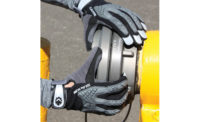Structural masonry walls support the gym and auditorium, which can hold 350 and 300 people respectively. The gym, large by middle school standards, boasts a regulation basketball court and two half courts perpendicular to the main court.
“Excavation required the removal of 10,000 cu yd of bedrock down to 20 ft to make room for a 35-car garage for staff members, a 6- to 7-ft-high crawl space and structural floors,” says Jason Godfy, project manager for Saunders Construction.
Making a Statement
Demolition waste was recycled except for materials contaminated by lead or asbestos. Preservation buffs were pleased to see the wood floor from the old gym cut into 4- by 8-ft sheets and selectively applied to the interior as paneling.
“From the beginning, we wanted this school to make a strong statement regarding the importance of energy conservation,” says Lou Novak, Boulder Valley School District project manager. “About 90% of the heating and cooling is provided by a geothermal, ground-source heat pump.”
Seventy boreholes averaging 370 ft deep, hidden beneath the athletic field, heat water flowing through 10 loops of pipe that feed pumps, compressors and heat exchangers in the mechanical plant in the crawl space. Depending on the season, fans move either heated or cooled air through ductwork and into classrooms, offices, common areas and hallways.
Additional passive power is provided by three tiers of south-facing solar panels that double as a partial shelter for bicycle parking. On sunny days, interior spaces require minimal artificial lighting, thanks to an array of 120 22-in.-diameter solar tubes that transmit natural light throughout the building. A mirror-like stainless steel finish inside the tubes ensures maximum light transmission.
Glass curtain walls and storefront-style window walls illuminate the corridors, student commons and main entry, where they wrap the plaza and a roundabout for passenger drop-off. The energy-efficient, aluminum-clad wood windows are durable and virtually maintenance free.
“Touch screens, located in common areas and linked to an interactive energy-use system, allow students to monitor power consumption and temperature,” says Godfy. “It’s a great learning tool.”
Heat-island effects were significantly reduced and LEED points earned from the below-grade garage and the restriction of non-staff parking to angled slots on adjacent streets.
“A small rooftop garden is primarily a demonstration project but could also serve as a teaching aid,” says Novak. “Meanwhile, the climbing rock removed for access purposes during construction was reinstalled along with new trees and sod.”
In the zero-waste cafeteria/kitchen, a food pulper compresses waste, squeezing out liquids and leaving a residue that is retrieved and recycled as compost by a commercial vendor.
Young says a white rooftop was considered, but a four-ply gray-gravel roof was installed instead. “Light-colored gravel is still reflective,” he says. “White-painted gravel was considered, but eventually rejected because of the involved approval process.”
Casey Middle School expects to receive additional LEED credits for educational programming and is currently working with consultants to develop a green curriculum. Meanwhile, Eco-Cycle of Boulder will implement an overall zero-waste recycling program in about six months.
Project Team
$26.2 million
Owner: Boulder Valley School District Boulder
General Contractor: Saunders Construction Inc.
Architect: RB+B Architects Inc.
Engineers: JVA Inc., EMC Engineers Inc.
Among the Subcontractors: MKK Consulting Engineers Inc., Rocky Mountain Geothermal Inc., Central Mechanical, Glover Masonry, Simple Solar Systems
Start: Jan. 2009 Finish: Aug. 2010






Post a comment to this article
Report Abusive Comment